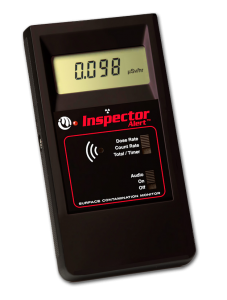Geiger Counter Information
What is a Geiger Counter & How it Works
The Geiger counter was invented in 1908 by Hans Geiger to detect radiation. A Geiger counter is used to measure ionizing radiation through the use of neon, argon and halogen gas. A Geiger counter uses a tube that collects the particles and a positively charged wire to attract negatively charged electrons. Any positively charged electrons are repelled.
As radiation is picked up by the sensor, it is reacting with the gases inside the counter and releasing electrons, which are picked up by the wire. The more electrons that are being picked up, the higher level of radiation the substance contains. A speaker inside the system makes a clicking noise each time an electron is detected.
How to Use a Geiger Counter
When using a Geiger counter, determine the levels of background radiation beforehand. Anything radioactive will be noticeably different. Next, it is important to put the tube near the surface being examined for at least 20 minutes for accuracy. Compare the results to the background levels to see if anything has changed.
Some Geiger counters will use flashes and signals, while others may use a meter to show the level of radiation present. If a meter is not available on the device, the number of clicks will indicate the radiation present. However, a Geiger counter does not pick up all forms of radiation; it is only sensitive to the different forms of ionizing radiation. It can detect alpha, beta, gamma, X-ray and cosmic radiation present. Other forms of radiation will be missed by the sensor.
Geiger counters can also be adjusted to be more or less sensitive to radiation. By adjusting the sensor, levels of radiation that are not harmful can be ignored. Counters should also be tuned every few years to prevent errors, as with most electronic devices the counters require maintenance.
Uses
Geiger counters are important for use in several industries. In medicine the counters are used to identify sources of radiation coming off of equipment. The use of Geiger counters prevents patients and health workers from being exposed to dangerous levels of radiation. The counter is also used to detect emissions from nuclear power generation.
Readings
A reading of above 100 CPM is considered to be a concerning amount of radiation. Such a high reading indicates that there is some level of contamination present beyond normal levels. If one should detect high levels of radiations in an area one should avoid the area and limit exposure time.
http://www.ehow.com/how_2074400_use-geiger-counter.html
http://www.ehow.com/about_5366052_factors-affect-geiger-counter.htm
http://makezine.com/projects/geiger-counter/
http://modernsurvivalblog.com/nuclear/radiation-geiger-counter-the-radiation-network/
http://io9.com/heres-how-geiger-counters-really-work-1425617341

